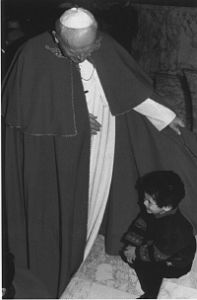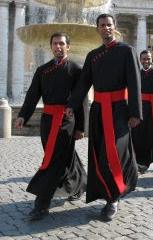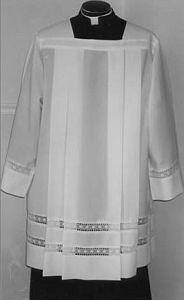The Catholic Doors Ministry
presents the Bible Course
“Roman Catholic Vestments”
- “What do you call that thing that the priest is wearing?” This is a commonly asked question that Catholics ask because they do not know what to call the clothing that is being worn by the clergy. The purpose of this course is to educate the faithful in the area of vestments.
- The word “vestment” comes from the Latin. It simply means clothing. Now, it is generally used to represent the garments that are worn by the ministers of religion in the performance of their sacred duties.
- Vestments are a sacramental. That means they are set apart and blessed by the Church to excite good thoughts and to increase devotion in those who see and those who use them. They are the uniform of the priest when he is “on duty,” while he is exercising the functions of his ministry and using the sacred powers which he received at his ordination. The clothing that is worn by the priest while he is not “on duty,” it is not called vestments.
- The Mass vestments were originally ordinary garments of the ancient Roman world. While the the fashions of dressing have changed with the passing centuries, the priest continued to wear at the altar the ancient Roman costume of his predecessors.
- Thus, the priest, vested for mass, is a wonderful witness to the historical continuity of the Catholic Church with the primitive Church of Rome, founded by the Prince of the Apostles.
| |
6. THE ALB – The alb is a long, white linen liturgical vestment with tapered sleeves. It is a garment (or robe) that is worn by the priest during the Holy Mass. It symbolizes the innocence and purity that should adorn the soul of the priest who ascends the altar. While it is white in the Western Church, it can be of any color in the Eastern Church. |
 |
7. THE AMICE – The amice is a liturgical vestment consisting of an oblong piece of white linen that is worn around the neck and shoulders and partly under the alb. It measures 36″ x 24″ with two 36″ strings of twill tape. Originally, the purpose of the amice was as a neckcloth to protect the valuable chasuble and stole. Until 1972, the amice was an obligatory vestment. Now it is optional, provided that the alb worn by the priest does cover all of his clothes underneath. If his clothes is not all covered, an amice must still be used. The amice is associated with the “helm of salvation.” While putting it on, the priest would say, “Lord, give me strength to conquer the temptations of the devil.” |
 |
8. THE BIRETTA – The biretta is a stiff square-shapped hat with silk trim and tuft. It has three or four ridges, called “horns,” across the crown. It is worn by the clergy. It is black for priests, deacons, and seminarians, purple for bishops, and scarlet for cardinals. The biretta is now optional for clerics who are celebrating or concelebrating Mass. |
 |
9. THE CAMAURO – The camauro is the crimson velvet cap trimmed with white ermine, worn by the Pope, instead of the biretta, on non-liturgical occasions. The camauro, like the biretta, evolved from the academic cap of the Middle Ages. Unlike the biretta, however, it did not evolve much. The camauro in its present form was established by the twelfth century. |
 |
10. THE CAPPA – “Cappa” or “Cope” is Latin for “choir cape, black cape.” It is a long black liturgical mantle, open in front and fastened at the breast with a band or clasp. Sometimes it has a hood. It was worn in choir during the Divine Office by the clergy of cathedral churches and by many religious, and is still retained by the Dominicans during winter months. |
 |
11. THE CAPPA MAGNA – The cappa magna (literally, “great cape”) is a voluminous ecclesiastical garment with a long train, proper to cardinals, bishops, and certain other honorary prelates. No longer mandatory (and therefore rare), the cappa magna was never abolished and still appears in the Ceremonial of Bishops. Ordinarily scarlet for cardinals and purple for bishops, the garment dates to the first millennium and its train has varied in length over the ages. |
 |
12. THE CAPPELLO ROMANO – A cappello romano, meaning Roman hat, is a hat with a wide, circular brim and a rounded rim worn by the clergy. It is made of either beaver fur or felt, and lined in white silk. It serves no ceremonial purpose, being primarily a practical item. The wearing of it is optional, but it is never worn during services. It is generally uncommon outside of Rome today. The pope wears a red cappello with gold cords. All other clerics wear black cappelli. A cardinal may have a cappello with red and gold cords with scarlet lining. A bishop’s may have green and gold cords with violet lining. A priest may substitute black lining for his. Cappelli worn by deacons and seminarians have no distinguishing items. |
 |
13. THE CASSOCK – The cassock, also known as a soutane, comes in a number of styles or cuts, though no particular symbolism attaches to these. It usually has 33 buttons (symbolic of the years of the life of Jesus) down the front. There are two types of cassock: the ordinary cassock and the choir cassock. A band cincture or fascia is also worn with both types of cassocks. The ordinary cassock is the black cassock worn by most clerics. Choir dress cassocks for bishops, protonotaries apostolic, and honorary prelates are purple. |
 |
14. THE CHASUBLE – The chasuble is the vestment that is put on over all the others during Liturgical services. Originally this was a very full garment, shaped like a bell and reaching almost to the feet all the way round. During a bad artistic period, the 18th and 19th century especially, the Chasuble suffered much from a process of shortening a stiffening. Today there is a return to the historical and beautiful, ample, nicely draping Chasubles. The Chasuble symbolizes the virtue of charity, and the yoke of unselfish service for the Lord, which the priest assumes at ordination. |
 |
15. THE CHIMERE – The chimere is a sleeveless gown, usually of red, but sometimes of black material of quality and derived from the Spanish word “Zammarvia” that means “riding cloak.” It is an upper robe of a Bishop. This garment serves as a symbol of the mantle of a prophet. The chimere is only worn by the Bishop because it signifies him as chief proclaimer and defender of the faith in the apostolic tradition. |
 |
16. THE CINCTURE – The cincture is the cord used as a belt to gird the Alb. It symbolizes the virtues of chastity and continence (meaning “the exercise of self constraint in sexual matters”) required of the priest. It comes in many colors. |
 |
17. THE CROSIER – The word “crosier” comes from the Latin word “crocia” which means “crook or bend.” It is a Pastoral Staff, the symbol of authority and jurisdiction. This ecclesiastical ornament is conferred on bishops at their consecration and on mitred abbots at their investiture. It is used by these prelates in performing certain solemn functions. |
 |
18. THE DALMATIC – The dalmatic is an outer, sleeved tunic that came to Rome from Dalmatia, whence its name. It is worn in place of the chasuble, by the deacon and sub-deacon during Solemn Mass. It symbolizes the joy and happiness that are the fruit of dedication to God. |
 |
19. THE DOUILLETTE – The douillette (or greca or cappotto) is a long, loose-fitting, double-breasted cloak worn over the cassock or simar by all clerics. It is white for the Pope, black for all other clerics. The douillette came into the Roman Church through France. It was originally employed in the East, where it was known as the greca. It was adapted from civil wear for the clergy in 1812, and has changed little since. |
 |
20. THE EPISCOPAL RING – The Pope’s ring, known as the Fisherman’s Ring, is used as the personal and unique seal of that reigning Pontiff. It is destroyed when he dies. Cardinals make use of the cardinalatial ring bestowed upon them at consistory, and bishops use the episcopal ring bestowed upon them at their consecration. It should be noted that the Pope is the Bishop of Rome. Pontifical doctors make use of a doctoral ring at academic functions when they would use the doctoral biretta. Priests, both diocesan and order, may use the ring of profession during liturgical events. The ring is a gift of the Pope to each new bishop. |
 |
21. THE FANON – The fanon is a shoulder cape that only the pope wear. It consist of two pieces of white silk ornamented with narrow woven stripes of red and gold. It is nearly circular in shape with a round hole in the middle for the head to pass through, and with a small gold cross embroidered in front. It is worn over the alb, and only at solemn pontifical Mass. |
 |
22. THE FARRAIOLO – The ferraiolo is a full cape, now almost completely out of style, worn by clerics in abito piano. It is scarlet watered silk for a cardinal, violet silk for a bishop, violet wool for a protonotary apostolic, and black wool for any other degree of cleric. The Pope does not make use of a ferraiolo. |
 |
23. THE GAUNTLETS – The gauntlets are the liturgical gloves that are an option for bishops to use during liturgical celebrations (as celebrant or concelebrant, not in choir). They are made of silk, and extend partially past the wrist. They can match the liturgical color, or can be always white. The gauntlets, like so many vestments, developed out of necessity to help keep the hands of the bishops warm during liturgical ceremonies in cold, stone churches. Since they became optional after Vatican II, the gauntlets are today seen only very rarely. |
 |
24. THE GLOVES – Gloves used by clerics must always be black, and are not used during a liturgical celebration. The master of ceremonies alone may make use of white gloves, and is the only one allowed gloves while vested in choir. The Pope also uses white. |
 |
25. THE HUMERAL VEIL – The Humeral Veil is worn so as to cover the back and shoulders (where it gets its name) and its two ends hang down in front. To prevent its falling from the shoulders, it is fastened across the chest with clasps or ribbons attached to the border. The Humeral Veil is worn by the priest or deacon in processions of the Blessed Sacrament, in giving Benediction, in carrying the Host to its repository on Holy Thursday, and bringing it back to the altar on Good Friday. In processions of the Blessed Sacrament and at Benediction given with the monstrance, only the hands are placed under the humeral veil; in other cases, it covers the sacred vessel which contains the Host. The Humeral Veil is usually and properly some shade of white (from ivory to white is acceptable). |
 |
26. THE MANIPULE – The manipule is an ornamental vestment of colored silk or damask over the left forearms. Originally this vestment was a handkerchief carried in the left hand or thrown over the left arm. It symbolizes the labor and hardship the priest must expect in his ardent apostolate. |
 |
27. THE MANTELETTA – The mantelletta, while formerly worn by all bishops and some of the monsignori, is now only used by the seven protonotaries apostolic de numero. It is a short, violet mantle with slits for the arms, worn over the rochet and choir cassock. |
 |
28. THE MITRE – The mitre is the common headdress of bishops, worn at liturgical functions. It is either precious, golden (orphreyed), or simple (simplex). The precious mitre is worn by celebrants, the simple by concelebrants, and the golden by the celebrant at an ordination. All the cardinals wear a damasked mitre (simplex) in presence of the Pope. It is very tall, and is made of layered white damask silk. |
 |
29. THE MOZZETTA – The mozzetta is the short shoulder-cape worn by bishops over the choir cassock and rochet in choir dress. It is made of the same material and color as the cassock. |
 |
30. THE PALLIUM – The pallium is only worn by archbishops, patriarchs, and the Pope, as symbol of the authority of metropolitan. It is a thin band of white wool worn around the neck with extensions front and back. It has black crosses on it, and is pinned to the chasuble in three places around the neck. |
 |
31. THE PASTORAL STAFF (OF THE POPE) – The staff, used by the Popes in place of a crozier since Pope Paul VI (died 1978), were silver color with a crucifix and corpus at the top. Throughout history, the Popes have not used the Pastoral Staff. Only since Pope Paul VI have they used it. |
 |
32. THE PECTORAL STAFF – The pectoral cross is a small cross, usually about 6 inches in height, worn around the neck of a bishop and suspended by either the cord (in liturgical vestments or choir) or the chain (in abito piano). The cord is scarlet and gold for a cardinal; green and gold for a bishop. |
 |
33. THE ROCHET – The rochet is a knee-length, white vestment worn over the choir cassock by bishops in choir. It is often, but not necessarily, very fancy with lace and linen. It is not interchangeable with the surplice, contrary to the belief of many bishops. It is distinct from the surplice not in the level of decoration, but in the sleeve: the sleeve of a rochet, like an alb, fits flush against the choir cassock; the sleeve of a surplice is fuller, and often bell-shaped. |
 |
34. THE SIMAR – The simar (or zimarra), is only worn by the ranks of the episcopate. It is the most common dress for a bishop. It resembles a cassock in many respects, but it is not properly a cassock, as it has in addition to it a shoulder-cape of the same material and color. It is always black (except for the Pope), and the trim is scarlet for cardinals and amaranth-red for bishops. |
 |
35. THE SOPRANA – The soprana is a black wool cloak worn by any cleric, but most notably by Roman seminarians. It is rarely seen outside of Rome today. This cloak originated in the seminaries of Rome, and used to include colored silk trim and facings, which were specific to each seminary. |
 |
36. THE STOLE – Roman magistrates wore a long scarf when engaged in their official duties, just as our judges wear a court gown. Whenever a priest celebrates Mass or administers the Sacraments, he wears the stole as a sign that he is occupied with an official priestly duty. When placing the stole about his neck, in vesting for Mass, the priest begs God to give him on the last day the ‘garment of immortality’ that was forfeited by our sinful first parents. |
 |
37. THE SURPLICE – The surplice, like the rochet, is a knee-length, white vestment worn over the choir cassock, but by priests, deacons, and seminarians rather than bishops. It is typically simple in design, but can be very fancy. It is distinct from the rochet not in the level of decoration, but in the sleeve: the sleeve of a rochet, like an alb, fits flush against the choir cassock; the sleeve of a surplice is fuller, and often bell-shaped. |
 |
38. THE TRIREGNO – The triregno, or Papal tiara, is the triple crown reserved to Popes. No Pope since Pope Paul VI (died 1978) has been crowned with it, and no Pope since John XXIII (died 1963) has made use of it. The tiara developed from the mitre. The three crowns are symbolic of the Pope’s three-fold powers: potestas magisterii, potestas regimini, and potestas ministerii. [Meaning: “teaching, sanctifying, and governing.”] |
 |
39. THE ZUCCHETTO – The zucchetto is the silk skullcap worn by the Catholic clergy. It is white for the Pope, scarlet for a cardinal, and violet for a bishop. Priests may use a black cloth zucchetto for everyday wear, but not during the liturgy. |
My source: catholicdoors.com/courses/roman.htm
Back to: Liturgical Vestments
7 Tips and Resources for a Fruitful Prayer Life this Advent
A Spiritual Christmas Crib: Preparing Our Hearts for Christ’s Coming
Catholic liturgies avoid Christmas decorations, carols in Advent
How to live up this Advent? Here are some great ideas
